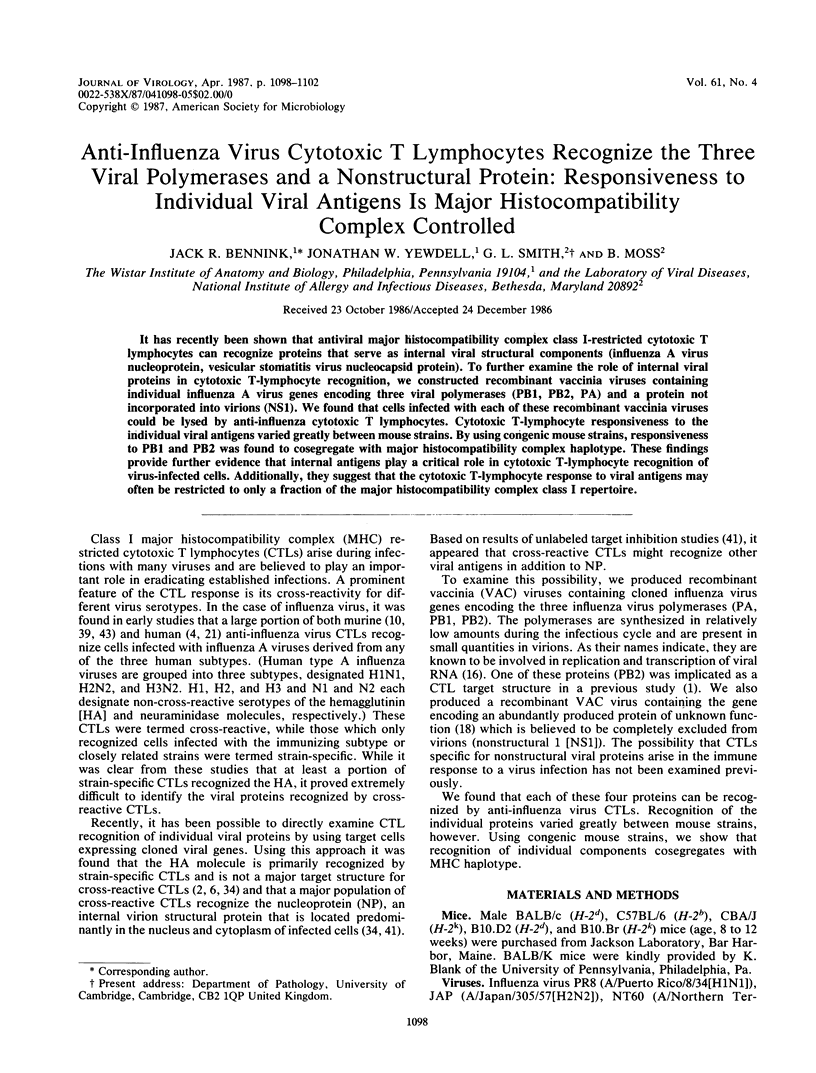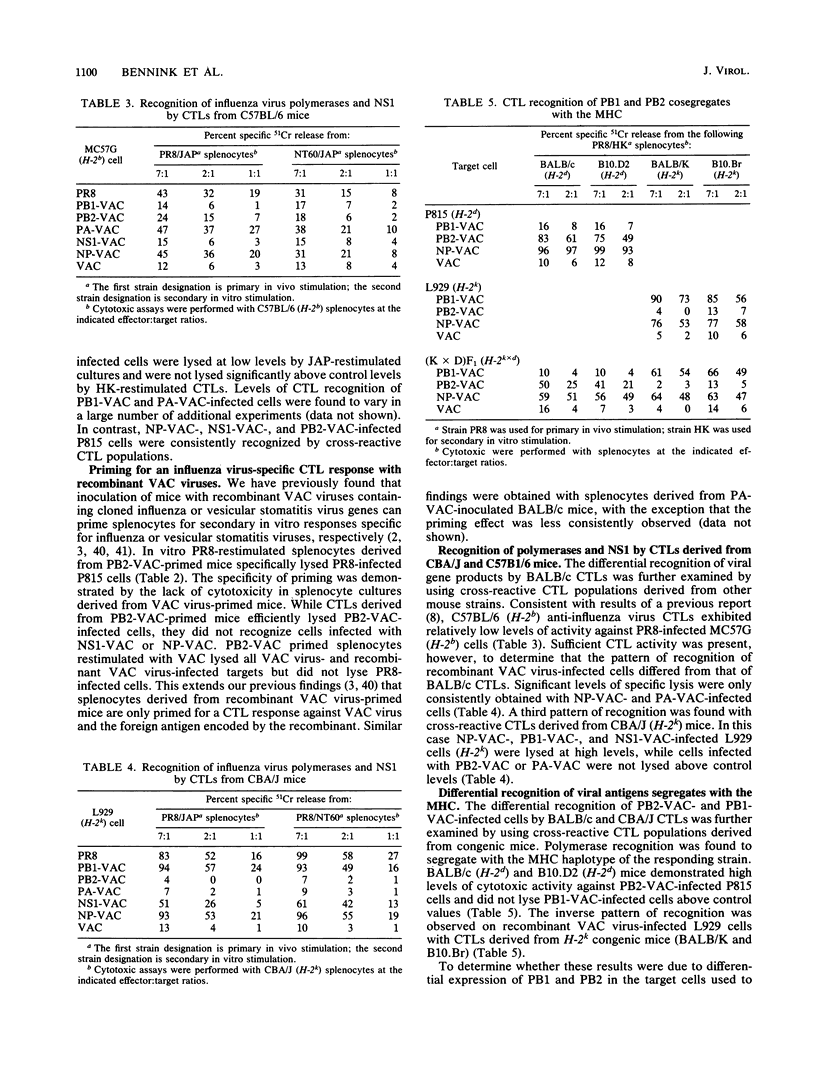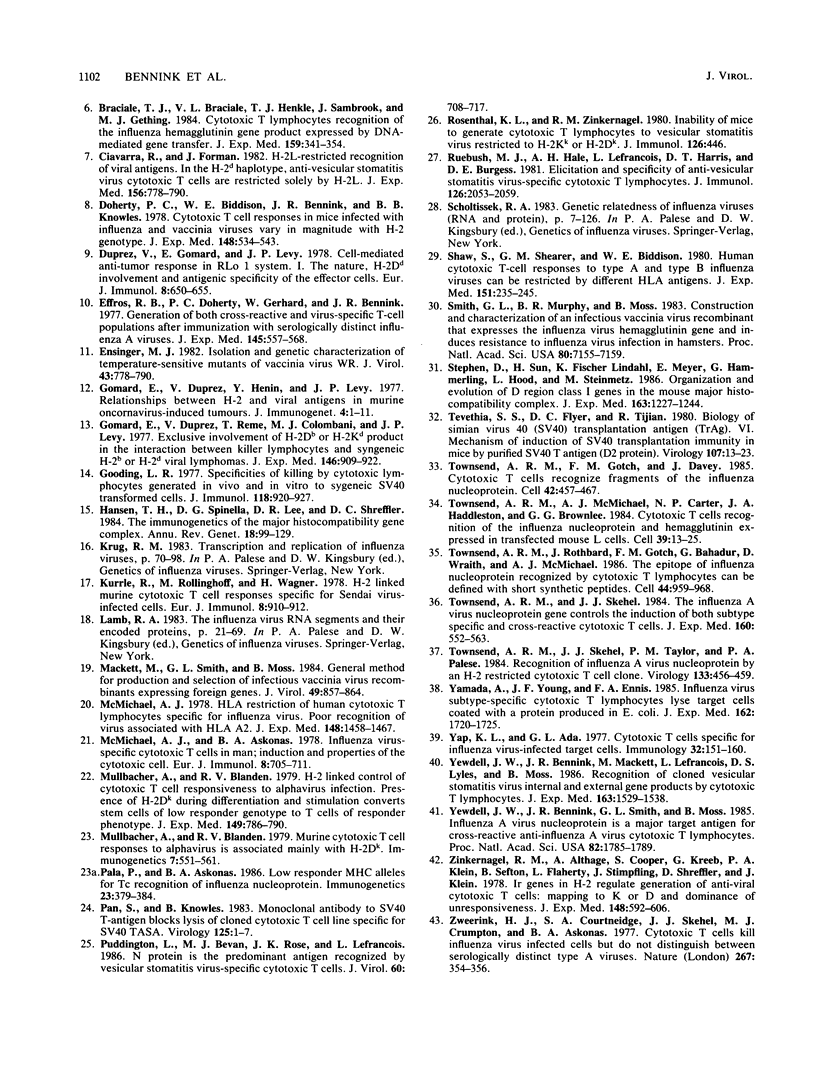Abstract
It has recently been shown that antiviral major histocompatibility complex class I-restricted cytotoxic T lymphocytes can recognize proteins that serve as internal viral structural components (influenza A virus nucleoprotein, vesicular stomatitis virus nucleocapsid protein). To further examine the role of internal viral proteins in cytotoxic T-lymphocyte recognition, we constructed recombinant vaccinia viruses containing individual influenza A virus genes encoding three viral polymerases (PB1, PB2, PA) and a protein not incorporated into virions (NS1). We found that cells infected with each of these recombinant vaccinia viruses could be lysed by anti-influenza cytotoxic T lymphocytes. Cytotoxic T-lymphocyte responsiveness to the individual viral antigens varied greatly between mouse strains. By using congenic mouse strains, responsiveness to PB1 and PB2 was found to cosegregate with major histocompatibility complex haplotype. These findings provide further evidence that internal antigens play a critical role in cytotoxic T-lymphocyte recognition of virus-infected cells. Additionally, they suggest that the cytotoxic T-lymphocyte response to viral antigens may often be restricted to only a fraction of the major histocompatibility complex class I repertoire.
Full text
PDF




Selected References
These references are in PubMed. This may not be the complete list of references from this article.
- Bennink J. R., Yewdell J. W., Gerhard W. A viral polymerase involved in recognition of influenza virus-infected cells by a cytotoxic T-cell clone. Nature. 1982 Mar 4;296(5852):75–76. doi: 10.1038/296075a0. [DOI] [PubMed] [Google Scholar]
- Bennink J. R., Yewdell J. W., Smith G. L., Moller C., Moss B. Recombinant vaccinia virus primes and stimulates influenza haemagglutinin-specific cytotoxic T cells. Nature. 1984 Oct 11;311(5986):578–579. doi: 10.1038/311578a0. [DOI] [PubMed] [Google Scholar]
- Bennink J. R., Yewdell J. W., Smith G. L., Moss B. Recognition of cloned influenza virus hemagglutinin gene products by cytotoxic T lymphocytes. J Virol. 1986 Mar;57(3):786–791. doi: 10.1128/jvi.57.3.786-791.1986. [DOI] [PMC free article] [PubMed] [Google Scholar]
- Biddison W. E., Shaw S., Nelson D. L. Virus specificity of human influenza virus-immune cytotoxic T cells. J Immunol. 1979 Feb;122(2):660–664. [PubMed] [Google Scholar]
- Bijnen A. B., Schreuder I., Volkers W. S., Parlevliet J., van Rood J. J. The lymphocyte activating influence of the HLA-A region. J Immunogenet. 1977 Feb;4(1):1–5. doi: 10.1111/j.1744-313x.1977.tb00608.x. [DOI] [PubMed] [Google Scholar]
- Blank K. J., Freedman H. A., Lilly F. T-lymphocytes response to Friend virus-induced tumour cell lines in mice of strains congenic at H--2. Nature. 1976 Mar 18;260(5548):250–252. doi: 10.1038/260250a0. [DOI] [PubMed] [Google Scholar]
- Braciale T. J., Braciale V. L., Henkel T. J., Sambrook J., Gething M. J. Cytotoxic T lymphocyte recognition of the influenza hemagglutinin gene product expressed by DNA-mediated gene transfer. J Exp Med. 1984 Feb 1;159(2):341–354. doi: 10.1084/jem.159.2.341. [DOI] [PMC free article] [PubMed] [Google Scholar]
- Ciavarra R., Forman J. H-2L-restricted recognition of viral antigens In the H-2d haplotype, anti-vesicular stomatitis virus cytotoxic T cells are restricted solely by H-2L. J Exp Med. 1982 Sep 1;156(3):778–790. doi: 10.1084/jem.156.3.778. [DOI] [PMC free article] [PubMed] [Google Scholar]
- Doherty P. C., Biddison W. E., Bennink J. R., Knowles B. B. Cytotoxic T-cell responses in mice infected with influenza and vaccinia viruses vary in magnitude with H-2 genotype. J Exp Med. 1978 Aug 1;148(2):534–543. doi: 10.1084/jem.148.2.534. [DOI] [PMC free article] [PubMed] [Google Scholar]
- Duprez V., Gomard E., Levy J. P. Cell-mediated anti-tumor response in the RLmale 1 system. I. T nature, H-2Dd involvement and antigenic specificity of the effector cells. Eur J Immunol. 1978 Sep;8(9):650–655. doi: 10.1002/eji.1830080909. [DOI] [PubMed] [Google Scholar]
- Effros R. B., Doherty P. C., Gerhard W., Bennink J. Generation of both cross-reactive and virus-specific T-cell populations after immunization with serologically distinct influenza A viruses. J Exp Med. 1977 Mar 1;145(3):557–568. doi: 10.1084/jem.145.3.557. [DOI] [PMC free article] [PubMed] [Google Scholar]
- Ensinger M. J. Isolation and genetic characterization of temperature-sensitive mutants of vaccinia virus WR. J Virol. 1982 Sep;43(3):778–790. doi: 10.1128/jvi.43.3.778-790.1982. [DOI] [PMC free article] [PubMed] [Google Scholar]
- Gomard E., Duprez V., Reme T., Colombani M. J., Levy J. P. Exclusive involvement of H-2Db or H-2Kd product in the interaction between T-killer lymphocytes and syngeneic H-2b or H-2d viral lymphomas. J Exp Med. 1977 Oct 1;146(4):909–922. doi: 10.1084/jem.146.4.909. [DOI] [PMC free article] [PubMed] [Google Scholar]
- Gooding L. R. Specificities of killing by cytotoxic lymphocytes generated in vivo and in vitro to syngeneic SV40 transformed cells. J Immunol. 1977 Mar;118(3):920–927. [PubMed] [Google Scholar]
- Hansen T. H., Spinella D. G., Lee D. R., Shreffler D. C. The immunogenetics of the mouse major histocompatibility gene complex. Annu Rev Genet. 1984;18:99–129. doi: 10.1146/annurev.ge.18.120184.000531. [DOI] [PubMed] [Google Scholar]
- Kurrle R., Röllinghoff M., Wagner H. H-2-linked murine cytotoxic T cell responses specific for sendai virus-infected cells. Eur J Immunol. 1978 Dec;8(12):910–912. doi: 10.1002/eji.1830081216. [DOI] [PubMed] [Google Scholar]
- Mackett M., Smith G. L., Moss B. General method for production and selection of infectious vaccinia virus recombinants expressing foreign genes. J Virol. 1984 Mar;49(3):857–864. doi: 10.1128/jvi.49.3.857-864.1984. [DOI] [PMC free article] [PubMed] [Google Scholar]
- McMichael A. J., Askonas B. A. Influenza virus-specific cytotoxic T cells in man; induction and properties of the cytotoxic cell. Eur J Immunol. 1978 Oct;8(10):705–711. doi: 10.1002/eji.1830081007. [DOI] [PubMed] [Google Scholar]
- McMichael A. HLA restriction of human cytotoxic T lymphocytes specific for influenza virus. Poor recognition of virus associated with HLA A2. J Exp Med. 1978 Dec 1;148(6):1458–1467. doi: 10.1084/jem.148.6.1458. [DOI] [PMC free article] [PubMed] [Google Scholar]
- Mullbacher A., Blanden R. V. H-2-linked control of cytotoxic T-cell responsiveness to alphavirus infection. Presence of H-2Dk during differentiation and stimulation converts stem cells of low responder genotype to T cells of responder phenotype. J Exp Med. 1979 Mar 1;149(3):786–790. doi: 10.1084/jem.149.3.786. [DOI] [PMC free article] [PubMed] [Google Scholar]
- Pala P., Askonas B. A. Low responder MHC alleles for Tc recognition of influenza nucleoprotein. Immunogenetics. 1986;23(6):379–384. doi: 10.1007/BF00372670. [DOI] [PubMed] [Google Scholar]
- Pan S., Knowles B. B. Monoclonal antibody to SV40 T-antigen blocks lysis of cloned cytotoxic T-cell line specific for SV40 TASA. Virology. 1983 Feb;125(1):1–7. doi: 10.1016/0042-6822(83)90058-2. [DOI] [PubMed] [Google Scholar]
- Puddington L., Bevan M. J., Rose J. K., Lefrançois L. N protein is the predominant antigen recognized by vesicular stomatitis virus-specific cytotoxic T cells. J Virol. 1986 Nov;60(2):708–717. doi: 10.1128/jvi.60.2.708-717.1986. [DOI] [PMC free article] [PubMed] [Google Scholar]
- Rosenthal K. L., Zinkernagel R. M. Inability of mice to generate cytotoxic T lymphocytes to vesicular stomatitis virus restricted to H-2Kk or H-2Dk. J Immunol. 1981 Feb;126(2):446–451. [PubMed] [Google Scholar]
- Ruebush M. J., Hale A. H., Lefrancois L., Harris D. T., Burgess D. E. Elicitation and specificity of anti-vesicular stomatitis virus-specific cytotoxic T lymphocytes. J Immunol. 1981 May;126(5):2053–2059. [PubMed] [Google Scholar]
- Shaw S., Shearer G. M., Biddison W. E. Human cytotoxic T-cell responses to type A and type B influenza viruses can be restricted by different HLA antigens. Implications for HLA polymorphism and genetic regulation. J Exp Med. 1980 Jan 1;151(1):235–245. doi: 10.1084/jem.151.1.235. [DOI] [PMC free article] [PubMed] [Google Scholar]
- Smith G. L., Murphy B. R., Moss B. Construction and characterization of an infectious vaccinia virus recombinant that expresses the influenza hemagglutinin gene and induces resistance to influenza virus infection in hamsters. Proc Natl Acad Sci U S A. 1983 Dec;80(23):7155–7159. doi: 10.1073/pnas.80.23.7155. [DOI] [PMC free article] [PubMed] [Google Scholar]
- Stephan D., Sun H., Lindahl K. F., Meyer E., Hämmerling G., Hood L., Steinmetz M. Organization and evolution of D region class I genes in the mouse major histocompatibility complex. J Exp Med. 1986 May 1;163(5):1227–1244. doi: 10.1084/jem.163.5.1227. [DOI] [PMC free article] [PubMed] [Google Scholar]
- Tevethia S. S., Flyer D. C., Tjian R. Biology of simian virus 40 (SV40) transplantation antigen (TrAg). VI. Mechanism of induction of SV40 transplantation immunity in mice by purified SV40 T antigen (D2 protein). Virology. 1980 Nov;107(1):13–23. doi: 10.1016/0042-6822(80)90268-8. [DOI] [PubMed] [Google Scholar]
- Townsend A. R., Gotch F. M., Davey J. Cytotoxic T cells recognize fragments of the influenza nucleoprotein. Cell. 1985 Sep;42(2):457–467. doi: 10.1016/0092-8674(85)90103-5. [DOI] [PubMed] [Google Scholar]
- Townsend A. R., McMichael A. J., Carter N. P., Huddleston J. A., Brownlee G. G. Cytotoxic T cell recognition of the influenza nucleoprotein and hemagglutinin expressed in transfected mouse L cells. Cell. 1984 Nov;39(1):13–25. doi: 10.1016/0092-8674(84)90187-9. [DOI] [PubMed] [Google Scholar]
- Townsend A. R., Rothbard J., Gotch F. M., Bahadur G., Wraith D., McMichael A. J. The epitopes of influenza nucleoprotein recognized by cytotoxic T lymphocytes can be defined with short synthetic peptides. Cell. 1986 Mar 28;44(6):959–968. doi: 10.1016/0092-8674(86)90019-x. [DOI] [PubMed] [Google Scholar]
- Townsend A. R., Skehel J. J., Taylor P. M., Palese P. Recognition of influenza A virus nucleoprotein by an H-2-restricted cytotoxic T-cell clone. Virology. 1984 Mar;133(2):456–459. doi: 10.1016/0042-6822(84)90413-6. [DOI] [PubMed] [Google Scholar]
- Townsend A. R., Skehel J. J. The influenza A virus nucleoprotein gene controls the induction of both subtype specific and cross-reactive cytotoxic T cells. J Exp Med. 1984 Aug 1;160(2):552–563. doi: 10.1084/jem.160.2.552. [DOI] [PMC free article] [PubMed] [Google Scholar]
- Yamada A., Young J. F., Ennis F. A. Influenza virus subtype-specific cytotoxic T lymphocytes lyse target cells coated with a protein produced in E. coli. J Exp Med. 1985 Nov 1;162(5):1720–1725. doi: 10.1084/jem.162.5.1720. [DOI] [PMC free article] [PubMed] [Google Scholar]
- Yap K. L., Ada G. L. Cytotoxic T cells specific for influenza virus-infected target cells. Immunology. 1977 Feb;32(2):151–159. [PMC free article] [PubMed] [Google Scholar]
- Yewdell J. W., Bennink J. R., Mackett M., Lefrancois L., Lyles D. S., Moss B. Recognition of cloned vesicular stomatitis virus internal and external gene products by cytotoxic T lymphocytes. J Exp Med. 1986 Jun 1;163(6):1529–1538. doi: 10.1084/jem.163.6.1529. [DOI] [PMC free article] [PubMed] [Google Scholar]
- Yewdell J. W., Bennink J. R., Smith G. L., Moss B. Influenza A virus nucleoprotein is a major target antigen for cross-reactive anti-influenza A virus cytotoxic T lymphocytes. Proc Natl Acad Sci U S A. 1985 Mar;82(6):1785–1789. doi: 10.1073/pnas.82.6.1785. [DOI] [PMC free article] [PubMed] [Google Scholar]
- Zinkernagel R. M., Althage A., Cooper S., Kreeb G., Klein P. A., Sefton B., Flaherty L., Stimpfling J., Shreffler D., Klein J. Ir-genes in H-2 regulate generation of anti-viral cytotoxic T cells. Mapping to K or D and dominance of unresponsiveness. J Exp Med. 1978 Aug 1;148(2):592–606. doi: 10.1084/jem.148.2.592. [DOI] [PMC free article] [PubMed] [Google Scholar]
- Zweerink H. J., Courtneidge S. A., Skehel J. J., Crumpton M. J., Askonas B. A. Cytotoxic T cells kill influenza virus infected cells but do not distinguish between serologically distinct type A viruses. Nature. 1977 May 26;267(5609):354–356. doi: 10.1038/267354a0. [DOI] [PubMed] [Google Scholar]


